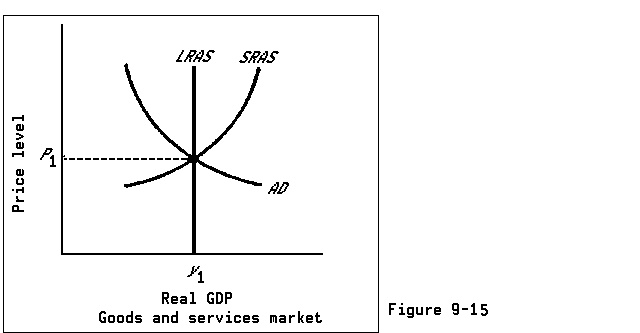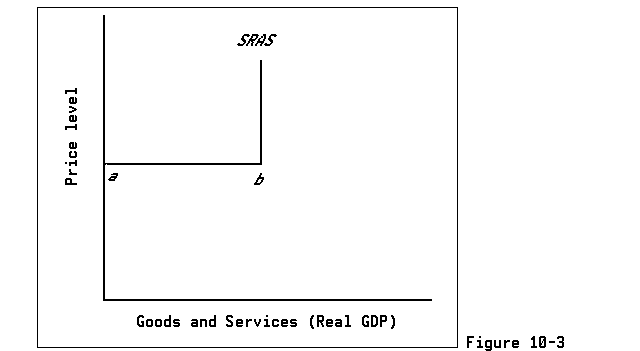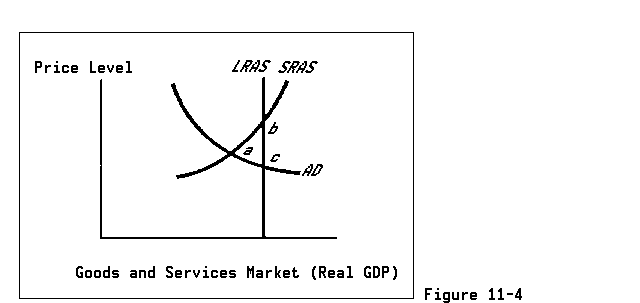
Econ 2012 Section 5 Principles of Macroeconomics, Midterm 2 (November 2, 1998), Fall 1998
Instructor: Vijaya Sharma, University of Colorado at Denver
Instruction:
The test has 40 multiple choice questions. Each question carries equal weight. Use the separately provided answer sheet to circle the correct choice in each question. Hand in only the answer sheet when you are done.
MULTIPLE CHOICE QUESTIONS
1. Which of the following would increase GDP?
a. Ford Motor Company begins to produce and sell cars in Japan.
b. Mercedes-Benz begins to produce and sell cars in Alabama.
c. An American investor buys 100 shares of Ford stock.
d. An American investor purchases 100 shares of Mercedes-Benz stock.
2. When the expenditure approach is used to measure GDP, the major components of GDP are
a. consumption, investment, indirect business taxes, and depreciation.
b. wages, rents, interest, self-employment income, and corporate profits.
c. wages, corporate profits, depreciation, and indirect business taxes.
d. consumption, investment, government expenditures, and net exports.
a. $3.1 trillion
b. $4 trillion
c. $5.2 trillion
d. $6.76 trillion
a. price level is different for the two periods.
b. share of production carried out in the nonmarket or household sector is different for the periods.
c. bundle of goods produced during the periods is quite similar.
d. size of the export-import sector differs for the two periods.
5. CPI tends to overstate inflation because
a. producers are likely to change the number of goods that they sell from year to year.
b. producers will generally reduce the quality of goods as prices increase over time.
c. consumers will tend to substitute away from goods that become more expensive.
d. consumers will usually reduce their consumption of goods when they become relatively cheaper.
6. Real GDP = nominal GDP multiplied by the
a. GDP deflator.
b. GDP deflator in the base year divided by the GDP deflator in the current year.
c. GDP deflator in the current year divided by the GDP deflator in the base year.
d. consumer price index.
7. The Consumer Price Index is designed to measure
a. the amount of goods consumed in a single year.
b. the change in consumer purchasing patterns from one year to another.
c. the change in the cost of purchasing the typical consumer market basket of goods from one year to another.
d. the change in the price of a single good from one year to another
8. Disposable income equals
a. national income minus personal income and federal taxes.
b. personal income minus personal taxes.
c. net national product per capita minus personal taxes.
d. national income minus social security taxes plus corporate dividends.
9. The type of unemployment caused by changes in the business cycle is
a. structural unemployment.
b. natural unemployment.
c. frictional unemployment.
d. cyclical unemployment.
a. Derrick, a discouraged worker, who has given up searching for a job because he cannot find one.
b. Gwen, a medical student, who is still in college and is not working.
c. Morgan, who is employed part-time but desires a full-time job.
d. Jordan, who is out of work, but has been actively seeking a job by going on job interviews.
11. The recessionary phase of the business cycle is characterized by
a. reduced output and increased unemployment.
b. reduced output and reduced unemployment.
c. increased output and increased unemployment.
d. increased output and reduced unemployment.
a. Unemployment is 33 percent and labor force participation 40 percent.
b. Unemployment is 20 percent and labor force participation 80 percent.
c. Unemployment is 20 percent and labor force participation 60 percent.
d. Unemployment is 25 percent and labor force participation 80 percent.
13. The natural rate of unemployment is not zero because
a. some workers will always have few skills.
b. unemployment will always rise during the recessionary phase of the business cycle.
c. the economy is characterized by dynamic change leading to structural changes in the economy and by imperfect information needing time to match available jobs with available skills..
d. not every member of society is capable of participating in the labor force.
14. If the consumer price index (CPI) was 100 in 1995 and 107 in 1996, inflation during 1996 was
a. zero; prices were stable.
b. 7 percent.
c. 107 percent.
d. There is not enough information to determine the inflation rate.
15. Stagflation occurs when inflation is
a. high and unemployment is high.
b. low and unemployment is high.
c. high and the growth of real output is rapid.
d. low and the growth of real output is slow.
a. -5 percent.
b. 3 percent.
c. 5 percent.
d. 11 percent.
a. price level effect.
b. real balance effect.
c. income effect.
d. interest rate effect.
18. Which of the following correctly labels the curves in the AD/AS model below?
a. (1) is LRAS, (2) is SRAS, and (3) is AD
b. (1) is SRAS, (2) is LRAS, and (3) is AD
c. (1) is AD, (2) is SRAS, and (3) is LRAS
d. (1) is LRAS, (2) is AD, and (3) is SRAS

19. Which of the following will most likely accompany an unanticipated reduction in aggregate demand?
a. an increase in prices
b. an increase in unemployment
c. an increase in real GDP
d. an increase in the demand for resources
20. A decline in the real interest rate in the loanable funds market will cause the
a. aggregate demand curve to shift to the right.
b. aggregate demand curve to shift to the left.
c. long-run aggregate supply curve to shift to the left.
d. natural rate of unemployment to fall.
a. Output will increase and prices fall.
b. Output will increase and prices rise.
c. Output will decrease and prices rise.
d. Output will decrease and prices fall.
22. Which of the following will most likely increase the economy's long-run aggregate supply?
a. advances in technology
b. unfavorable weather conditions in agricultural areas
c. an increase in the expected inflation rate
d. a low rate of investment
23. Which one of the following will increase short-run aggregate supply in the United States?
a. an increase in wage rates
b. an increase in interest rates
c. a drought in the Midwest agricultural states
d. a reduction in resource prices
24. The permanent income hypothesis indicates that a temporary increase in income will
a. lead to a larger increase in aggregate demand than a similar increase in income that was expected to be permanent (continue into the future).
b. lead to a larger increase in saving than a similar increase in income that was expected to be permanent (continue into the future).
c. lead people to increase their spending by a larger amount than their increase in income.
d. lead people to decrease their saving.
25. Pre-Keynesian economists (often called classical economists) believed that a free market, capitalist economy would
a. automatically provide for the full employment of resources because prices are flexible.
b. provide for maximum aggregate income as long as there was government intervention.
c. suffer prolonged periods of recessions and depressions.
d. be inherently unstable because of fluctuating aggregate demand.
26. Within the Keynesian model, if an economy operates below full employment,
a. a reduction in wage rates and resource prices will soon restore full employment equilibrium.
b. a reduction in the real interest rate will soon restore full-employment equilibrium.
c. an increase in the real interest rate will soon restore full-employment equilibrium.
d. the economy may remain below full employment for a long time unless aggregate demand increases.
a. an increase in resource prices that will stimulate aggregate demand and direct the economy to long-run equilibrium
b. a decrease in resource prices that will reduce costs and shift SRAS to the right, directing the economy to long-run equilibrium
c. a continuation of this price level and output in the long run
d. a shift in LRAS to the left as the result of an increase in the expected inflation rate

a. actual unemployment will equal the natural rate of unemployment.
b. buyers and sellers will have correctly anticipated the price level P1.
c. output y1 is equal to the economy’s long-run potential output.
d. all of the above are correct.

a. increase in prices.
b. increase in unemployment.
c. increase in interest rates and money income, but employment and real income will remain constant.
d. increase in employment, output, and real income.
30. If the marginal propensity to consume (MPC) is .75 or 3/4, what is the expenditure multiplier?
a. 0.25
b. 2.0
c. 3.0
d. 4.0
a. $80 billion
b. $100 billion
c. $300 billion
d. $400 billion
a. the classical range
b. the Keynesian range
c. the flexible wage and price range
d. the new classical range
\

a. a decrease in tax rates
b. a decrease in government expenditures
c. an increase in the budget deficit
d. none of the above
34. Keynesian analysis implies that an active budget deficit is
a. always necessary to ensure full employment.
b. proper during slack economic conditions but highly inappropriate if the economy is already operating at capacity.
c. of little consequence unless there is a corresponding change in the money supply.
d. an effective method of dealing with inflation.
35. If a recession is about to begin, the Keynesian view indicates that policy makers should
a. balance the budget.
b. increase government spending and/or reduce taxes.
c. decrease government spending while holding taxes constant.
d. hold government spending constant and increase taxes.
a. Inflation would fall.
b. Inflation would rise.
c. A recession would develop.
d. Interest rates would fall.
37. The crowding-out effect refers to the possibility that
a. an expansionary fiscal policy causes inflation.
b. a restrictive fiscal policy is an effective weapon against inflation.
c. increase in private savings will crowd out the taxable income of households.
d. increase in the federal deficit will result in higher interest rates, which will crowd out private investment.
a. stimulate aggregate demand and employment.
b. retard aggregate demand and employment.
c. increase the real rate of interest.
d. exert little or no impact on the real interest rate, aggregate demand, and employment.
a. increase AD and move the economy toward point b.
b. increase AD and move the economy toward point c.
c. increase SRAS and move the economy toward point b.
d. decrease SRAS and move the economy toward point c.

40. Automatic stabilizers are government programs that tend to
a. reduce the ups and downs in aggregate demand without legislative action.
b. bring expenditures and revenues automatically into balance without legislative action.
c. signal Congress that legislative changes are needed.
d. increase tax collections automatically during a recession.
Answer Key to Midterm 2, Fall 1998
|
Question # |
Correct Choice |
Question # |
Correct Choice |
Question # |
Correct Choice |
Question # |
Correct Choice |
|
1 |
b |
11 |
a |
21 |
b |
31 |
b |
|
2 |
d |
12 |
d |
22 |
a |
32 |
b |
|
3 |
b |
13 |
c |
23 |
d |
33 |
b |
|
4 |
b |
14 |
b |
24 |
b |
34 |
b |
|
5 |
c |
15 |
a |
25 |
a |
35 |
b |
|
6 |
b |
16 |
c |
26 |
d |
36 |
b |
|
7 |
c |
17 |
b |
27 |
b |
37 |
d |
|
8 |
b |
18 |
a |
28 |
d |
38 |
d |
|
9 |
d |
19 |
b |
29 |
a |
39 |
a |
|
10 |
d |
20 |
a |
30 |
d |
40 |
a |